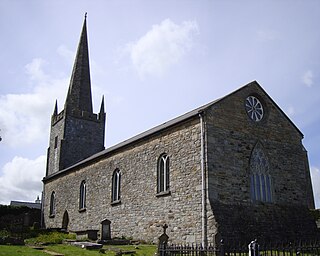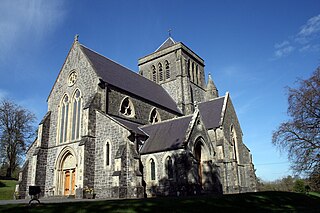
The Bishop of Clifton is the Ordinary of the Roman Catholic Diocese of Clifton in the Province of Birmingham, England.
The Apostolic Vicariate of the Lancashire District was an ecclesiastical jurisdiction of the Catholic Church in England. It was led by a vicar apostolic who was a titular bishop. The apostolic vicariate was created in 1840 and was replaced by two dioceses in 1850.

John Briggs was an English prelate of the Roman Catholic Church. He served as the first Bishop of Beverley from 1850 to 1860.

The Bishop of Killala is an episcopal title which takes its name after the village of Killala in County Mayo, Ireland. In the Roman Catholic Church it remains a separate title, but in the Church of Ireland it has been united with other bishoprics.

The Bishop of Kilmore is an episcopal title which takes its name after the parish of Kilmore, County Cavan in Ireland. In the Roman Catholic Church it remains a separate title, but in the Church of Ireland it has been united with other bishoprics.
The Bishop of Meath is an episcopal title which takes its name after the ancient Kingdom of Meath. In the Roman Catholic Church it remains as a separate title, but in the Church of Ireland it has been united with another bishopric.
The Bishop of Kilfenora was a separate episcopal title which took its name after the village of Kilfenora in County Clare in the Republic of Ireland. In both the Church of Ireland and the Roman Catholic Church, the title is now united with other bishoprics.
Hugh O'Reilly was an Irish prelate of the Roman Catholic Church. He served as Bishop of Kilmore from 1625 to 1628 and Archbishop of Armagh from 1628 to 1653.

The Archbishop of Dublin is an archiepiscopal title which takes its name from Dublin, Ireland. Since the Reformation, there have been parallel apostolic successions to the title: one in the Catholic Church and the other in the Church of Ireland. The archbishop of each denomination also holds the title of Primate of Ireland.
The Bishop of Emly was a separate episcopal title which took its name after the village of Emly in County Tipperary, Republic of Ireland. In both the Catholic Church and the Church of Ireland, it has been united with other sees.
William Gibson was an English Roman Catholic prelate. He was president of the English College, Douai from 1781 to 1790, and later became a bishop, serving as the Vicar Apostolic of the Northern District from 1790 to 1821.
Francis George Mostyn (1800–1847) was a Roman Catholic bishop who served as the Vicar Apostolic of the Northern District of England from 1840 to 1847.
William Riddell (1807–1847) was a Roman Catholic bishop who briefly served as the Vicar Apostolic of the Northern District of England in 1847.
Thomas Kelly was an Irish prelate of the Roman Catholic Church. He served as Bishop of Dromore from 1826 to 1828 and Archbishop of Armagh from 1828 to 1835.
Richard O'Reilly (1746–1818) was an Irish prelate of the Roman Catholic Church. He served as the Archbishop of Armagh and Primate of All Ireland from 1787 to 1818.
Michael O'Reilly was an Irish prelate of the Roman Catholic Church. He served as Bishop of Derry from 1739 to 1749 and Archbishop of Armagh from 1749 to 1758.
Ambrose O'Madden was an Irish prelate of the Roman Catholic Church. He served as the Bishop of Clonfert from 1713 to 1715.
Laurence Richardson was an Irish Roman Catholic prelate who served as the Bishop of Kilmore from 1747 to 1753.
John Brullaghhaun was an Irish prelate of the Roman Catholic Church in the mid 18th century.
Francis Kelly was an Irish prelate of the Roman Catholic Church in the 19th century.





